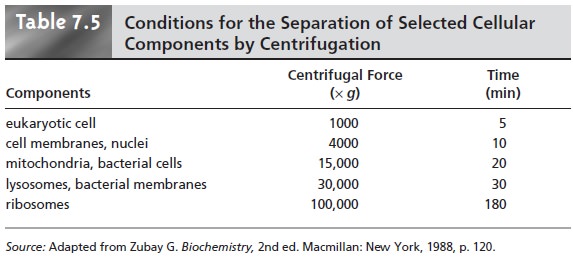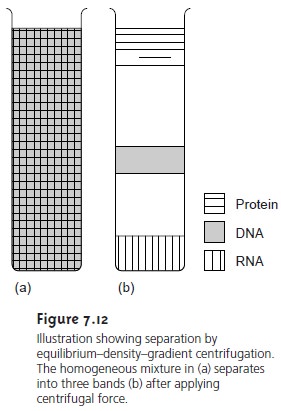Chapter: Modern Analytical Chemistry: Obtaining and Preparing Samples for Analysis
Classifying Separation Techniques: Separations Based on Mass or Density
Separations Based on Mass or Density
If there is a difference in the mass or density of the analyte and interferent, then a separation using centrifugation may be possible. The sample, as a suspension, is placed in a centrifuge tube and spun at a high angular velocity (high numbers of revolutions per minute, rpm). Particles experiencing a greater centrifugal force have faster sedimentation rates and are preferentially pulled toward the bottom of the centrifuge tube.
For
particles of equal
density the separation is based on mass, with heavier particles having greater
sedimentation rates. When
the particles are
of equal mass, those
with the highest
density have the
greatest sedimentation rate.
Centrifugation is of particular importance as a separation technique in biochem- istry. As shown
in Table 7.5, cellular
components can
be separated by centrifugation.12 For example, lysosomes can
be separated from other
cellular components by repeated differential centrifugation, in which
the sample is divided into a solid
residue and
a so- lution called
the supernatant. After
destroying the
cell membranes, the
solution is centrifuged at 15,000
x g (a centrifugal field strength that is 15,000
times that of the
Earth’s gravitational field) for
20 min, leaving
a residue of cell membranes
and mitochondria. The supernatant is isolated by decanting from the residue and is centrifuged at 30,000
x g for 30 min, leaving
a residue of lysosomes.

An alternative approach to differential centrifugation is equilibrium– density–gradient centrifugation. The sample is either placed
in a solution with a preformed density gradient or in a solution that,
when centrifuged, forms a density gradient. For example, density
gradients can be established
with solutions of sucrose or CsCl. During centrifugation, the sample’s com- ponents undergo sedimentation at a rate determined by their centrifugal force. Because the solution’s density increases toward
the bottom of the cen- trifuge tube, the sedimentation rate for each component decreases as it moves toward the bottom of the centrifuge tube. When a component reaches
a posi- tion where
its density is equal to that of the solution, the centrifugal force drops to zero and sedimentation stops.
Each component, therefore, is isolated as a separate band positioned where
the density of the component is equal to the
density of the solution. For example, a mixture of proteins, RNA, and
DNA can be separated in this way
since their densities are different. A densitygradient from 1.65 g/cm3 to 1.80 g/cm3 is
established using CsCl. Proteins, with a
density of less than 1.3 g/cm3 experience no sedimentation, whereas
RNA, with a density of greater than
1.8 g/cm3 collects as a residue
at the bottom
of the centrifuge tube. The DNA, which
has a density of approximately 1.7 g/cm3 separates as a band near the middle of the centrifuge tube (Figure 7.12).

Related Topics